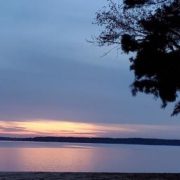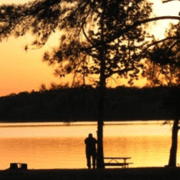-Press Release, FLW
Boater Robert Walser of Lexington, North Carolina, brought five bass to the weigh-in stage totaling 15 pounds, 10 ounces, to win Saturday’s T-H Marine FLW Bass Fishing League (BFL) North Carolina Division tournament on Kerr Lake. For his efforts, Walser took home $5,718.
“I fished flooded bushes and trees, mid-lake, along an approximately 20-mile stretch,” said Walser, who logged his 12th career win in BFL competition – tied for second most all-time. “I used a spinnerbait early, and then I flipped.”
Walser said he used a ½-ounce white-colored Rush Lures double-willow-bladed spinnerbait with a chartreuse and silver glitter Zoom Split Tail trailer on 20-pound-test Berkley Big Game line. He flipped a green-pumpkin Zoom Baby Brush Hog with a 3/0-sized Berkley Fusion 19 EWG hook and a 3/8-ounce Eco Pro tungsten flipping weight. For flipping, he opted for 20-pound-test Berkley Trilene 100-percent fluorocarbon line.

Boater Robert Walser of Lexington, North Carolina, brought five bass to the weigh-in stage totaling 15 pounds, 10 ounces, to win Saturday’s T-H Marine FLW Bass Fishing League (BFL) North Carolina Division tournament on Kerr Lake. For his efforts, Walser took home $5,718. (Photo courtesy FLW)
“I caught more than 30 keepers. It was hard initially, but after it warmed up it got easier,” said Walser. “We had a severe cold front come through Friday afternoon and the temperatures dropped rapidly – maybe 20 degrees in 30 minutes. It rained following the temperature change, so we had a few hours of cold rain. I think it had an effect on the fish I was targeting, but after noontime I caught four or five limits.”
Walser said he ended up weighing one off the spinnerbait, and the rest from the Brush Hog.
“Some of those spinnerbait fish in the morning were at those deeper bushes, and my Garmin Panoptix showed me the submerged bushes I couldn’t see, which really helped me out,” said Walser.
The top 10 boaters finished the tournament in:
1st: Robert Walser, Lexington, N.C., five bass, 15-10, $3,718 + $2,000 Ranger Cup Bonus
2nd: Dustin Clontz, Albemarle, N.C., five bass, 14-8, $1,909
3rd: Jake Frye, Charlotte, N.C., five bass, 14-0, $1,388
4th: Scott Beattie, Lincolnton, N.C., five bass, 13-10, $898
5th: Scott Hamrick, Denver, N.C., five bass, 13-8, $655
5th: Randy Childers, Anderson, S.C., five bass, 13-8, $805
7th: Jason Wilson, Lincolnton, N.C., five bass, 13-6, $990
8th: Carson Orellana, Mooresville, N.C., five bass, 13-0, $513
9th: Michael Stephens, Gastonia, N.C., five bass, 12-8, $456
10th: Ryan Deal, Indian Trail, N.C., five bass, 12-7, $399
Complete results can be found at FLWFishing.com.
Wilson caught a 5-pound, 1-ounce bass – the heaviest of the event in the Boater Division – and earned the day’s Boater Big Bass award of $420.
Jeff Scism of Shelby, North Carolina, won the Co-angler Division and $1,709 Saturday after catching five bass weighing 12 pounds, 5 ounces.
The top 10 co-anglers were:
1st: Jeff Scism, Shelby, N.C., five bass, 12-5, $1,709
2nd: Larry Freeman Jr., La Crosse, Va., five bass, 12-3, $1,105
3rd: Wayne Smelser, Rural Retreat, Va., five bass, 11-1, $620
4th: Charles Wood, Thomasville, N.C., four bass, 10-15, $609
5th: Maverick Canipe, Kings Mountain, N.C., five bass, 10-1, $342
6th: Dwayne Parton, Anderson, S.C., five bass, 9-13, $413
7th: Mark Murphy, Salisbury, N.C., five bass, 9-12, $285
8th: Barry Burford, Charlotte, N.C., five bass, 9-11, $256
9th: Grant McPeters, Marion, N.C., four bass, 9-10, $228
10th: John Cook, Matthews, N.C., five bass, 9-9, $199
Wood caught the largest bass in the Co-angler Division, a fish weighing in at 5 pounds, 4 ounces. The catch earned him the day’s Co-angler Big Bass award of $210.
The top 45 boaters and co-anglers in the region based on point standings, along with the five winners in each qualifying event, will be entered in the Oct. 10-12 BFL Regional Championship on Lake Hartwell in Seneca, South Carolina, presented by Navionics. Boaters will compete for a top award of a Ranger Z518L with a 200-horsepower outboard and $20,000, while co-anglers will fish for a new Ranger Z518L with a 200-horsepower outboard.
The T-H Marine FLW BFL North Carolina Division tournament on Kerr Lake was hosted by the Vance County Tourism Development Authority.
The 2019 BFL is a 24-division circuit devoted to weekend anglers, with 128 tournaments throughout the season, five qualifying events in each division. The top 45 boaters and co-anglers from each division, along with the five winners of the qualifying events, will advance to one of six regional tournaments where they are competing to finish in the top six, which then qualifies them for one of the longest-running championships in all of competitive bass fishing – the BFL All-American.
The 2019 BFL All-American will be held May 30-June 1 at the Potomac River in Marbury, Maryland, and is hosted by the Charles County Department of Recreation, Parks and Tourism and the Commissioners of Charles County. Top performers in the BFL can move up to the Costa FLW Series or even the FLW Tour.
For complete details and updated information visit FLWFishing.com. For regular updates, photos, tournament news and more, follow the T-H Marine FLW Bass Fishing League on FLW’s social media outlets at Facebook, Twitter, Instagram, and YouTube.








